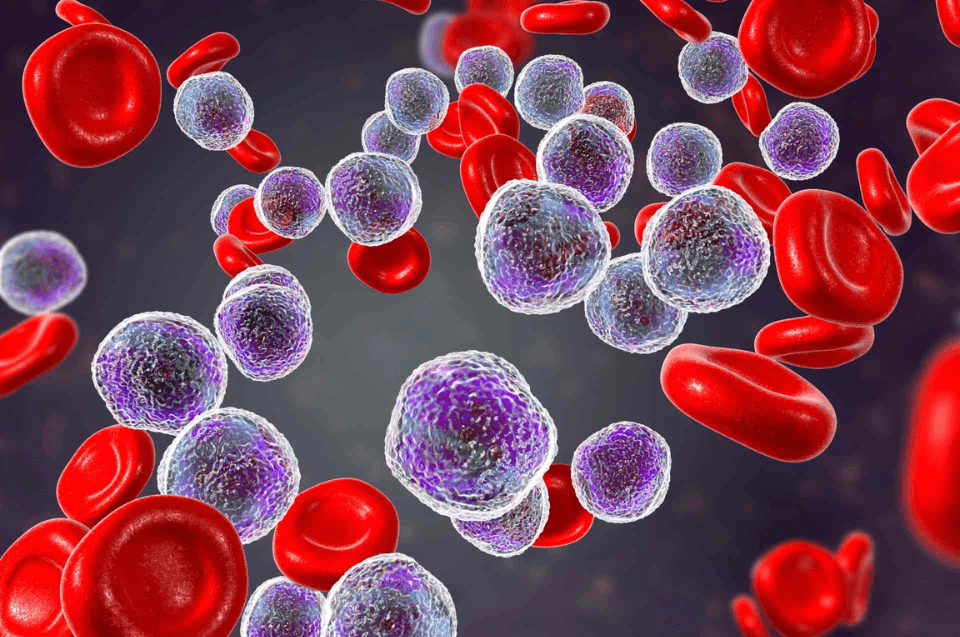Leukemia is a type of cancer that affects white blood cells, which are essential to the immune system. Unlike many other cancers, leukemia begins in the bone marrow — the soft tissue inside bones where blood cells are produced. The disease can develop quickly or slowly, and its severity depends on the type and stage at diagnosis.
In this article, you’ll understand what leukemia is, its main types, symptoms, diagnostic methods, and treatment options.
What is Leukemia?
Leukemia occurs when the bone marrow starts producing abnormal white blood cells that do not function properly and multiply uncontrollably. These cancerous cells replace healthy blood cells, impairing the body’s ability to fight infections, transport oxygen, and control bleeding.
The word “leukemia” comes from the Greek leukos (white) and haima (blood), referring to the high number of abnormal white blood cells in patients’ blood.
Main Types of Leukemia
Leukemia is classified based on how quickly the disease progresses (acute or chronic) and the type of blood cell affected (lymphocytic or myeloid). Based on this, the four main types of leukemia are:
1. Acute Lymphocytic Leukemia (ALL)
ALL primarily affects children, although it can also occur in adults. It is an aggressive form of leukemia with rapid progression. It compromises lymphocytes, a type of white blood cell, weakening the immune system.
2. Acute Myeloid Leukemia (AML)
More common in adults, AML also develops quickly and affects myeloid cells, which normally give rise to red blood cells, platelets, and other white blood cells.
3. Chronic Lymphocytic Leukemia (CLL)
CLL is more frequent in people over 60 and progresses slowly. In many cases, it is discovered accidentally during routine tests, before any symptoms appear.
4. Chronic Myeloid Leukemia (CML)
Characterized by an initial slower phase that may last months or years, CML can progress to a more aggressive phase. Like CLL, it is more common in adults.
Symptoms of Leukemia
Leukemia symptoms vary depending on the type of disease, but some signs are common across various forms. The most frequent include:
Extreme fatigue and weakness
Fever or chills
Unexplained weight loss
Frequent infections
Easy bruising or bleeding
Bone or joint pain
Night sweats
Swollen lymph nodes, liver, or spleen
Pale skin and shortness of breath
Since these symptoms can be mistaken for other illnesses, it’s essential to seek medical evaluation if they persist for more than a few days.
How Is Leukemia Diagnosed?
Leukemia diagnosis usually starts with a complete blood count, which can reveal changes in the number and shape of blood cells. If leukemia is suspected, additional tests may include:
Bone marrow aspiration (myelogram): collects samples of bone marrow for analysis.
Bone marrow biopsy: assesses the structure of the marrow and confirms the presence of cancerous cells.
Immunophenotyping: helps identify the subtype of leukemia through markers on the cells.
Cytogenetics and molecular biology: detect genetic changes associated with leukemia, helping guide treatment.
Leukemia Treatment
Leukemia treatment varies depending on the type, the patient’s age, general health, and the presence of specific genetic changes. The most common options include:
Chemotherapy
The cornerstone of treatment for most types of leukemia. It uses drugs that destroy cancer cells or stop them from multiplying.
Radiation Therapy
Less common, but may be used in specific cases, such as when there is infiltration of the central nervous system or as preparation for a bone marrow transplant.
Targeted Therapy
Uses drugs that act specifically on molecular changes present in leukemia cells, with fewer side effects than traditional chemotherapy.
Immunotherapy
Stimulates the patient’s own immune system to recognize and destroy cancer cells.
Bone Marrow Transplant
Indicated in more severe cases or in the event of relapse. It involves replacing the diseased marrow with healthy stem cells, usually from a compatible donor.
Prognosis and Quality of Life
With advances in diagnosis and therapies, many leukemia cases — especially those detected early — have shown positive outcomes. The prognosis depends on various factors, including the type of leukemia, patient age, and treatment response.
In addition to medical treatment, psychological support and family involvement are essential for emotional well-being and adherence to therapy.
Curiosities, Myths, and Scientific Advances About Leukemia
💡 Curiosity:
Leukemia was one of the first types of cancer in which bone marrow transplantation was successfully tested. The first successful transplant occurred in 1968.
❌ Myth:
“Leukemia is always a death sentence.” — This is not true. With current treatments, many types of leukemia have high remission rates, especially when diagnosed early.
✅ Fact:
Children with acute lymphocytic leukemia (ALL) have cure rates exceeding 85% in some specialized centers.
🧬 Scientific Advance:
In recent years, CAR-T cell therapy (chimeric antigen receptor) has revolutionized treatment for some resistant cases of leukemia. This technique involves genetically modifying the patient’s own immune cells to target and fight the cancer.
🔬 Promising Research:
Studies on gene editing (like CRISPR) and personalized immunotherapy are ongoing and offer hope for even more effective and less toxic treatments.



